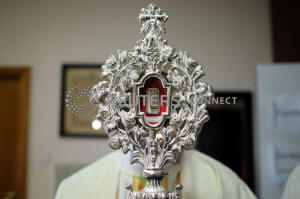|
The
wood piece, just a few centimetres (inches) long, was once kept
in the Basilica of Santa Maria Maggiore in Rome. It was handed
over earlier this week to the custodian of the Bethlehem church,
who said it brought "great honor to believers and pilgrims in
the area".
It was unveiled to the public at the Notre Dame of Jerusalem
Center, encased in a silver-colored ornamental table-top stand,
and will later be taken to Bethlehem, known to Christians as the
birthplace of Jesus.
There, it is expected to be placed inside Saint Catherine's
Church, adjacent to the Church of the Nativity in Manger Square,
in time for the lighting of the Christmas tree on Saturday.
The provenance of ancient relics is often questionable. Still,
they are revered by the Christian faithful, among them the
coachloads of pilgrims who squeeze through a narrow sandstone
entrance in the Church of the Nativity all year round to visit
the birth grotto that is its centrepiece.
"We are excited and thank the pope, the holy father, Francis,
for the gift and the right to safeguard the holy relic,"
Francesco Patton, Custos of the Holy Land for the Catholic
church, said in a statement.
The relic, according to the statement, dates back more than
2,000 years and "was part of the manger in which Baby Jesus was
laid". It was sent to the Vatican in the 7th century.
Bethlehem, in the West Bank, is always busy ahead of Christmas
on Dec. 25, especially for Christians who make up around 1% of
the Palestinian population in the West Bank, Gaza and East
Jerusalem.
(Reporting by Ammar Awad; Editing by Alex Richardson and Frances
Kerry)
[© 2019 Thomson Reuters. All rights
reserved.] Copyright 2019 Reuters. All rights reserved. This material may not be published,
broadcast, rewritten or redistributed.
Thompson Reuters is solely responsible for this content.

|
|






